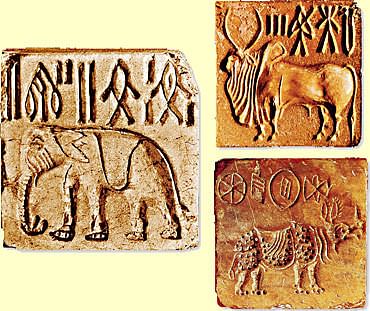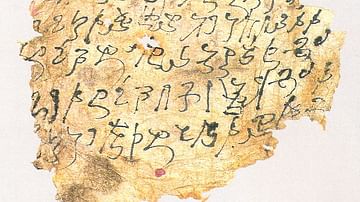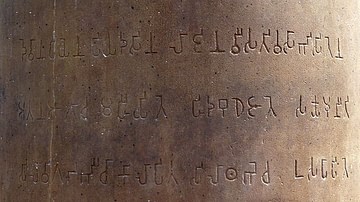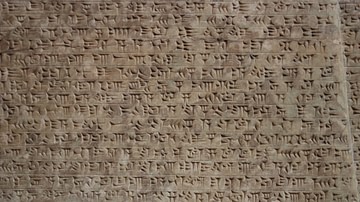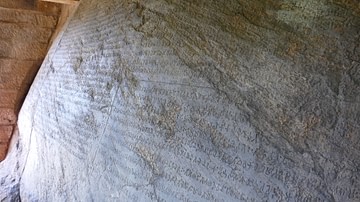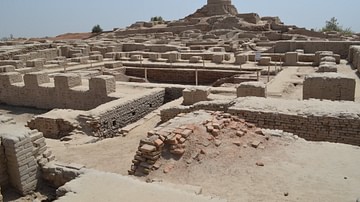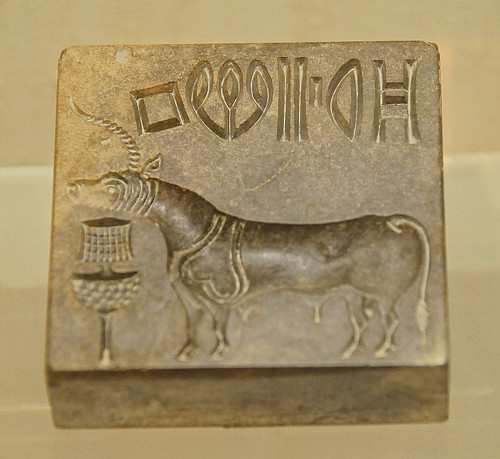
The Indus Script is the writing system developed by the Indus Valley Civilization and it is the earliest form of writing known in the Indian subcontinent. The origin of this script is poorly understood: this writing system remains undeciphered, there is no agreement on the language it represents, no bilingual texts have been found thus far and its connection with Indian writing systems proper (e.g. Brahmi, Devanagari and Bengali script) is uncertain. This is the main reason why the Indus Valley Civilization is one of the least known of the important early civilizations of antiquity.
During the early Harappan phase (c. 3500-2700 BCE), we find the earliest known examples of the Indus Script signs, attested on Ravi and Kot Diji pottery excavated at Harappa. Based on the fact that only one sign is displayed on the pottery surface, these examples represent a premature stage in the development of the Indus Script. Its full development was reached during the Urban period (c. 2600-1900 BCE), when longer inscriptions are recorded. Thousands of inscriptions are known from some 60 excavation sites: most of them are short, the average length is five signs and none of them is longer than 26 signs.
MATERIAL FORM & USE
Examples of Indus writing has been found on seals and seal impressions, pottery, bronze tools, stoneware bangles, bones, shells, ladles, ivory and on small tablets made of steatite, bronze and copper. Square stamp seals are the dominant form of Indus writing media; they are normally an inch square (2.54 centimetres) displaying the script itself on the top and an animal motif at the centre. They are chiefly made of steatite, some of them include a layer of a smooth glassy-looking material, but there are also examples of seals made of silver, faience and calcite. The seals were pressed on a pliable surface (e.g. clay) in order to replicate its image.
Since the Indus Script has not been deciphered yet, its use is not known with certainty and all that we think we know is based on archaeological evidence alone. Some of the seals may have been used as amulets or talismans, but they also had a practical function as a marker for identification. Since writing in ancient times is generally associated with elites trying to record and control transactions, it is also believed that the Indus Script was used as an administrative tool. There are also examples of this script being used on clay tags attached to bundles of goods that were traded between merchants; some of these clay tags have been found in the Mesopotamia region, well outside the Indus Valley, a testimony of how wide goods travelled in ancient times.
The Indus Script was also used in the context of 'narrative imagery': these images included scenes related to myths or stories, where the script was combined with images of humans, animals and/or imaginary creatures depicted in active poses. This last use resembles the religious, liturgical and literary use which is well attested in other writing systems.
decipherment attempts of the Indus Script
Slightly over 400 basic signs have been identified as part of the Indus Script. Only 31 of these signs occur over 100 times, while the rest were not used regularly. This leads researchers to believe that a large amount of the Indus Script was actually written on perishable materials, such as palm leaves or birch, which did not survive the destruction of time. This is hardly surprising considering that palm leaves, birch and bamboo tubes were widely used as writing surfaces in south and south east Asia. Some researchers have argued that the roughly 400 symbols can actually be reduced to 39 elementary signs, the rest being merely variations of styles and differences between scribes.
There are a number of factors preventing scholars from unlocking the mystery of the Indus Script. To begin with, some of the languages of ancient times, such as Egyptian, were deciphered thanks to the recovery of bilingual inscriptions, that is by comparing an unknown script with a known one. Unfortunately, no bilingual inscriptions have yet been found to allow the Indus Script to be compared to a known writing system.
Another obstacle for its decipherment relates to the fact that all of the inscriptions found so far are relatively short, fewer than 30 signs. This means that analysing recurring sign patterns, another technique that can help to unlock the meaning of a writing system, cannot be successfully performed for the Indus Script.
The last important reason why the Indus Script remains undeciphered, and possibly the most debated of all, is that the language (or languages) that the script represents is still unknown. Scholars have suggested a number of possibilities: Indo-European and Dravidian are the two language families most commonly favoured, but other options have been proposed as well, such as Austroasiatic, Sino-Tibetan, or perhaps a language family that has been lost. On the basis of the material culture associated with the Indus Valley Civilization, a number of scholars have suggested that this civilization was not Indo-European.
what is it known about the indus script?
Although decipherment of the Indus Script has not been possible yet, the majority of the scholars who have studied it agree on a number of points:
- The Indus Script was generally written from right to left. This is the case in most examples found, but there are some exceptions where the writing is bidirectional, which means that the direction of the writing is in one direction on one line but in the opposite direction on the next line.
- The representation of certain numerical values has been identified. A single unit was represented by a downward stroke, while semicircles were used for units of ten.
- The Indus Script combined both word signs and symbols with phonetic value. This type of writing system is known as "logo-syllabic", where some symbols express ideas or words while others represent sounds. This view is based on the fact that roughly 400 signs have been identified, which makes it unlikely that the Indus Script was solely phonetic. However, if the hypothesis that the hundreds of signs can be reduced to just 39 is true, that means that the Indus Script could be solely phonetic.
DECLINE OF THE INDUS SCRIPT
By 1800 BCE, the Indus Valley Civilization saw the beginning of its decline. As part of this process, writing started to disappear. As the Indus Valley Civilization was dying, so did the script they invented. The Vedic culture that would dominate North India for the centuries to come did not have a writing system, nor did they adopt the Indus Script. In fact, India would have to wait more than 1,000 years to see the return of writing.
